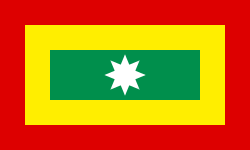Cartagena, Colombia

Cartagena (pronounced /kartaˈçena/ in Spanish; the usual English pronunciation is /ˌkaːtəˈheɪnə/ or /ˌkaɹɾəˈheɪnə/), also known as Cartagena de Indias (Cartagena of the West Indies), is a large city seaport on the northern coast of Colombia. It is the capital of the Bolívar Department. As of 2005, it has a population of roughly 895,400. It was founded in 1533 by Don Pedro de Heredia, and named after the port of Cartagena in Spain's Murcia region. It was a major centre of early Spanish settlement in the Americas, and continues to be an economic hub as well as a popular tourist destination.
Cartagena, Colombia Media
According to descriptions that survive, the homes of the prehistoric inhabitants of the city may have looked very similar to these Taíno culture huts in Baconao
Pedro de Heredia, founder of the city and explorer of its hinterland
The historic center is surrounded by 11 kilometers of defensive walls. These were complemented by fortifications along the coast, making Cartagena a militarily impregnable city. The walls, made in several stages, were designed to protect the city from continual pirate attacks, was built between 1614 and 1796.
The Convento de Santo Domingo, built between 1565 and 1630, is the oldest church of Cartagena de Indias.
Iglesia de San Pedro Claver built between 1580 and 1654. The body of Saint Peter Claver is located in its main altar.
Sanctuary of Saint Peter Claver. Peter Claver was a Spanish-born Jesuit priest who dedicated his life to helping the enslaved Africans, giving them a sense of their own personal dignity. He became the patron saint of slaves, seafarers, the Republic of Colombia and ministry to Africans.
Baroque Puerta del Reloj, built between 1704 and 1738, was the main city walls gate. This gate is one of the most successful works of the Hispanic American School of Fortification.
Painting of 1893 of Plaza de los Coches.











